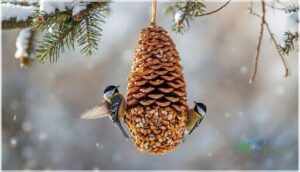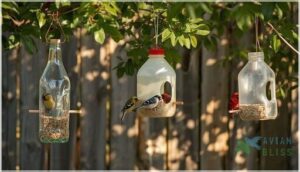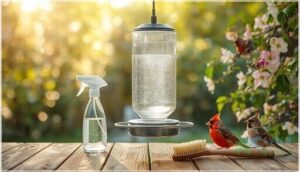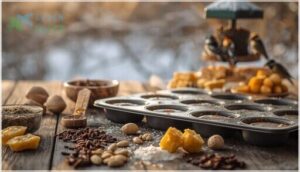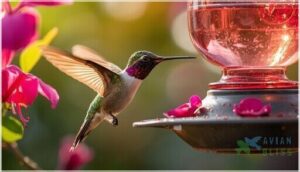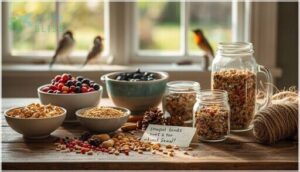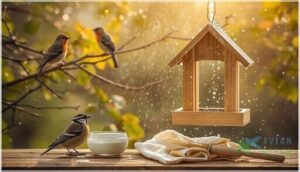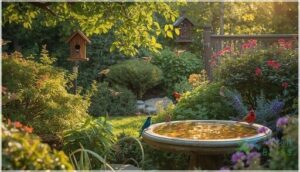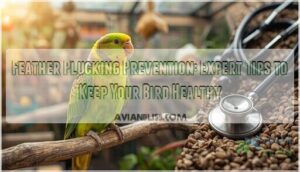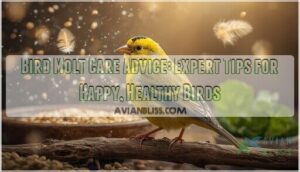This site is supported by our readers. We may earn a commission, at no cost to you, if you purchase through links.
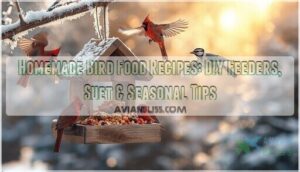 Your backyard could become the neighborhood hot spot for cardinals, chickadees, and woodpeckers—all without spending a fortune on commercial bird food. Fresh, homemade bird food recipes give you complete control over ingredients while delivering up to 90% more vitamins than those store-bought options sitting on the shelf.
Your backyard could become the neighborhood hot spot for cardinals, chickadees, and woodpeckers—all without spending a fortune on commercial bird food. Fresh, homemade bird food recipes give you complete control over ingredients while delivering up to 90% more vitamins than those store-bought options sitting on the shelf.
When you mix your own blends, you’re not just saving money; you’re creating nutrition specifically formulated to meet the needs of your feathered visitors throughout every season. From energy-packed suet cakes that help birds survive frigid winters to sugar-water solutions that fuel hummingbirds’ high-speed lifestyles, making your own bird food is easier than you think.
Whether you’re aiming to attract specific species or simply want to support local wildlife with better nutrition, these recipes and tips will transform your yard into a thriving bird sanctuary.
Table Of Contents
- Key Takeaways
- Benefits of Homemade Bird Food
- Simple DIY Bird Feeders
- Suet Recipes for Birds
- Homemade Hummingbird Food Recipes
- Parrot Food Recipes
- Bird-Friendly Plants and Fruits
- Tips for Making Homemade Bird Food
- Winter Bird Feeding Tips
- Bird Feeder Safety and Maintenance
- Creating a Bird-Friendly Yard
- Frequently Asked Questions (FAQs)
- What is the best homemade bird feed?
- How do you make a simple bird feed?
- What can I feed my bird if I don’t have bird food?
- What is a good home remedy for bird food?
- What grains can I use in bird food?
- Are there any harmful ingredients for birds?
- How to store homemade bird food safely?
- Can birds eat fresh or dried fruits?
- How to make bird food squirrel-proof?
- What birds should avoid homemade seed mixes?
- Conclusion
Key Takeaways
- Homemade bird food costs about 25% less than commercial options while delivering up to 90% more vitamins, giving you full control over ingredients and letting you skip fillers that make up 40% of store-bought blends.
- High-fat suet cakes (delivering 650–800 kcal per 100 grams) and species-specific recipes help birds survive winter and migration when natural food sources disappear, with ingredients like peanut butter, lard, and seeds providing essential energy.
- Simple sugar-water made from one part white sugar to four parts water perfectly matches natural flower nectar for hummingbirds, but skip fruit juices or dyes since they spoil fast and offer no nutritional benefit.
- Weekly feeder cleaning with hot soapy water and a 10% bleach solution cuts avian disease transmission by 80%, while native plants supporting 70% of your yard’s biomass create a complete ecosystem that attracts eight times more bird species.
Benefits of Homemade Bird Food
Making your own bird food isn’t just a hobby—it’s a smart way to support the birds in your backyard while keeping more money in your pocket. You’ll have complete control over what goes into every mix, ensuring your feathered visitors get the nutrients they actually need.
Let’s look at three key reasons why homemade bird food beats the store-bought stuff.
Attracting Birds to Your Yard
By attracting backyard birds to your yard, you’re creating a lively habitat that benefits both you and local wildlife. Homemade bird food recipes and well-placed bird feeders draw in more species than you’d imagine—in the U.S., over 70 million people use feeders annually. To make your space irresistible:
- Position bird feeders near native plants that provide natural cover and food
- Add water sources like birdbaths for drinking and bathing
- Include nesting habitats such as dense shrubs or birdhouses
- Practice predator control by placing feeders away from hiding spots
- Choose strategic feeder placement that’s visible yet safe
Also, remember that birdsong boosts well-being, so creating a welcoming environment can improve your happiness.
Providing Essential Nutrients
Once you’ve got birds visiting your yard, it’s time to think about what you’re actually feeding them. A balanced diet matters just as much for birds as it does for you. Your homemade mixes should include nutritious bird food with healthy ingredients like sunflower seeds for fatty acids, mealworms for amino acids and protein, and various seeds for vitamin needs and mineral balance.
Seasonal variation is key—birds need more fat in winter and extra protein during spring breeding. You can also provide fresh water sources year-round for the birds. By offering essential nutrients suited to bird nutrition, you’re supporting their health year-round.
Cost-Effective Alternative
Feeding birds well doesn’t have to drain your budget. Homemade bird food recipes usually cost about 25% less than commercial options, making DIY bird food a smart choice for your wallet and the birds. When you buy sunflower seeds, oats, and peanuts in bulk, you’re often paying less than half what you’d spend on pre-packaged mixes. That’s real savings you can feel.
Here’s where the benefits really add up:
- Ingredient cost savings: Bulk purchases of basic seeds can drop your per-pound cost from $10 to under $5
- Customization benefits: You control what goes in, skipping the fillers that make up 40% of some store-bought blends
- Supply chain flexibility: Local sourcing protects you from price shocks in the global bird feeding market
It’s a cost-effective alternative that keeps both birds and budgets healthy.
Simple DIY Bird Feeders
You don’t need fancy equipment to start feeding birds in your backyard. With a few household items and basic supplies, you can create feeders that work just as well as store-bought versions.
Here are three simple options that’ll get you started without breaking the bank.
Pine Cone Feeder
Pine cone feeders are one of the easiest homemade bird food recipes you can make. They attract chickadees, nuthatches, and woodpeckers right to your yard. Birds need extra calories during winter, making these DIY bird feeders essential.
Here’s what you’ll do:
- Select pine cones 10-15cm long for better seed capacity.
- Spread unsalted peanut butter across all surfaces.
- Roll in quality birdseed until fully coated.
- Hang 5+ feet high using cotton twine for best results.
Recycled Material Feeders
You can turn everyday recycled containers into DIY bird feeders that support both birds and the planet. Plastic bottles work wonderfully—just cut feeding ports, add wooden dowel perches, and fill with seed. Plastic feeder durability is impressive; they last five times longer than wood and resist weather damage year-round. Eco-friendly designs reduce carbon emissions by twelve times compared to virgin materials.
DIY containers like yogurt tubs or juice bottles attract species such as finches, cardinals, and chickadees while reducing disease transmission thanks to non-porous surfaces. Simple DIY bird feeders from recycled materials make bird feeder maintenance easier and help divert millions of pounds of plastic from landfills.
| Material | Best Bird Species |
|---|---|
| Plastic bottles | Cardinals, finches |
| Yogurt containers | Chickadees, sparrows |
| Juice cartons | Jays, nuthatches |
| Milk jugs | Cardinals, grosbeaks |
| HDPE containers | Multiple species |
Easy-Clean Feeders
Choosing easy-clean bird feeders transforms bird feeder maintenance from a chore into a quick task. Plastic, steel, or glass models are 90% easier to disinfect than wood, cutting cleaning time in half while boosting bird feeder safety.
Material hygiene matters—smooth surfaces reduce mold by 67%, and design features like removable bottoms accelerate cleaning efficiency considerably.
Cleaning frequency should be every two weeks for seed feeders, using a 10% bleach solution to eliminate pathogens. This simple routine aids disease reduction, cutting avian illnesses by 80% and keeping your DIY bird feeders welcoming for healthy, thriving birds.
Suet Recipes for Birds
Suet is like rocket fuel for birds—it’s packed with fat and energy that helps them power through cold weather and long migrations. Making your own suet cakes at home lets you control the ingredients and skip the fillers found in store-bought versions.
Here are three tried-and-true recipes that woodpeckers, nuthatches, and chickadees can’t resist.
Expert-Approved Suet Cakes Recipe
Want to give your backyard birds a high-energy treat they’ll love? This expert-approved suet cakes recipe is simple and delivers 650–800 kcal per 100 grams—perfect for keeping birds fueled through cold weather. Mix 1 cup of rendered animal fat with 1 cup of peanut butter, then stir in 2 cups of cornmeal and 1.5 cups of flour. Add birdseed, unsalted nuts, or dried fruit for extra nutrition.
Here’s what makes this peanut butter suet recipe work:
- High fat content aids winter insulation and feather health
- Customizable mix-ins attract different bird species to your yard
- Simple preparation requires only basic kitchen tools and ingredients
- Freezer-friendly cakes stay fresh for up to two months when properly wrapped
Pour into molds, refrigerate until firm, and watch woodpeckers and chickadees flock to your feeders.
Bird Buffet Suet Recipe
Looking for a crowd-pleaser your feathered guests won’t resist? The Bird Buffet suet recipe combines 1 cup of melted lard with 1 cup of creamy peanut butter. Then, mix in 2 cups of cornmeal and 1.5 cups of flour. Toss in birdseed, chopped almonds, raisins, or dried mealworms for variety. This homemade suet delivers over 500 kcal per cake—essential for winter bird feeding when natural food is scarce.
| Ingredient Type | Examples | Nutritional Benefits |
|---|---|---|
| Fats | Lard, coconut oil | High-calorie energy source |
| Protein | Peanut butter, mealworms | Muscle maintenance, feather health |
| Mix-ins | Nuts, dried fruit, seeds | Vitamins, fiber, minerals |
Freeze your homemade bird food for 2–3 hours, then store it in airtight containers for up to three months.
Peanut Butter Suet Recipe
This peanut butter suet recipe is a winter lifeline for your backyard birds. Combine 1 cup peanut butter with 1 cup lard, then stir in 2–3 cups of cornmeal and oats. The mix delivers about 230–270 kilocalories per 100 grams—perfect fuel for woodpeckers, nuthatches, and chickadees.
Freeze your homemade suet for 2–3 hours, store it refrigerated, and replace weekly during warm weather to prevent spoilage.
Homemade Hummingbird Food Recipes
Hummingbirds need a simple, reliable source of energy to fuel their incredibly fast metabolism. You don’t need fancy ingredients or complicated steps to keep these tiny visitors happy and healthy.
Here are two straightforward recipes that’ll have hummingbirds zipping through your yard all season long.
Simple Sugar-Water Recipe
Making hummingbird nectar is easier than you might think, and getting the nectar ratio right keeps these tiny visitors thriving. The standard simple sugar-water recipe uses one part white granulated sugar to four parts water, which matches the natural sweetness of their favorite flowers. This ratio promotes healthy energy levels without causing dehydration or kidney stress.
Here’s how you create perfect homemade hummingbird food:
- Mix one cup white sugar with four cups water—don’t use honey, brown sugar, or unsafe sugars.
- Skip red dye entirely; it poses serious health effects and isn’t needed.
- Dissolve sugar thoroughly in room-temperature or warm water.
- Store extra hummingbird nectar in your refrigerator for up to one week.
Seasonal adjustments help too—slightly sweeter ratios work during cold snaps.
Fruit-Infused Hummingbird Food
You might be tempted to add fruit juice or fresh berries to your hummingbird nectar, but skip it. Despite the appeal of fruit-infused bird food, hummingbirds don’t prefer these additions—and they’re actually risky.
Fruit safety becomes a real concern because juices and purees spoil dramatically faster than plain sugar-water, often within 24 hours in warm weather. This rapid spoilage rate encourages harmful bacteria and yeast growth, potentially making your hummingbirds sick. The nutritional value doesn’t improve either, since hummingbirds get their vitamins from insects, not nectar.
Bird preference studies confirm they stick with simple sucrose solutions. For recipe alternatives, just use the standard homemade hummingbird food recipe—one part white sugar to four parts water—and clean feeders every two days.
Parrot Food Recipes
Parrots need more than just seeds to stay healthy and happy. A balanced diet includes fresh vegetables, whole grains, and fruits that provide essential vitamins and minerals.
Here are four simple homemade recipes you can make to give your feathered friend nutritious variety.
Sweet Potato Balls
Sweet potato balls deliver a powerhouse of nutrition your parrot will love. With 769% of daily vitamin A and essential fiber, these homemade treats support vision, digestion, and immunity.
Mix cooked sweet potato with oats, peas, and banana, then roll into bite-sized balls. Serve 1-2 daily, following expert guidelines to balance natural sugars. Freeze extras for convenient, healthy bird food recipes anytime.
Veggies and Grains Chop Mix
Your parrot thrives when you offer a veggies and grains chop mix that balances nutrition perfectly. This homemade bird food recipe combines 50% vegetables like carrots (rich in vitamin A) and broccoli (packed with vitamin C) with 40% grains such as quinoa or oats, plus 10% herbs and fruits.
Chop mix prep involves finely chopping or blending ingredients into uniform, bite-sized pieces—preventing selective eating. Cook grains until tender at 350°F for about an hour to boost digestibility. Store portions in airtight containers: refrigerate for 3-4 days or freeze for up to 3 months. Introducing chop gradually, mixed with familiar foods, helps overcome food neophobia with 96% success rates.
- Mix vegetables and grains in roughly 50-40-10 proportions for nutritional balance
- Chop finely or blend to create uniform texture your parrot can’t pick through
- Freeze in ice cube trays for convenient single-serving storage methods
- Remove uneaten portions after 3-4 hours to prevent bacterial growth
Green Smoothie
Green smoothie recipes offer a revitalizing way to boost your parrot’s veggie intake, especially when they’re picky eaters. Blend 1–2 cups of fresh ingredients like spinach or kale with banana and berries for natural sweetness. You’ll want to avoid dairy completely—parrots can’t digest lactose. Pour the mixture into small cups or freeze in ice cube trays for easy serving methods during warm weather.
| Ingredient Type | Examples |
|---|---|
| Leafy Greens | Spinach, kale, Swiss chard |
| Fruits | Banana, mango, berries |
| Boosters | Chia seeds, wheatgrass powder |
This homemade bird food delivers essential nutrients like vitamins A, C, and K while keeping your feathered friend hydrated. Recipe variations can include soaked bird pellets for extra protein or steamed vegetables for sensitive digestion. Just remember—smoothie benefits shine brightest when you use safe ingredients and serve portions sized for your parrot’s species to prevent obesity from excess carbohydrates.
Pellet Paste
For picky parrots that turn their beaks up at pellets, pellet paste recipes offer a clever solution. Grind your preferred pellets into powder, then mix with seeds and water until you achieve a thick, spreadable consistency.
This homemade parrot food bridges the gap between seed-based diets and balanced pellet nutrition, helping your bird adjust to better dietary proportions while you control key ingredients and storage safety.
Bird-Friendly Plants and Fruits
You can do more than fill feeders—you can turn your yard into a natural buffet that birds return to season after season. Growing the right plants means less work for you and better nutrition for your feathered friends.
Let’s look at three simple ways to create a landscape that truly feeds birds.
Seed-Bearing Plants
Think of seed-bearing plants as nature’s original homemade bird food stations. Black oil sunflowers attract over 80% of goldfinch sightings, while native grasses and wildflowers like goldenrod provide seed nutrition that aids winter survival.
These bird-friendly plants don’t just beautify your yard—they create natural seed mix opportunities and promote bird dispersal. Native species also strengthen habitat impact, drawing diverse visitors year-round.
Fruit Trees for Birds
When you plant the right fruit trees, you’re creating a conservation role that extends far beyond your backyard. Native berries from trees like crabapple and serviceberry offer exceptional fruit nutrition—some contain up to 48% fat content, essential for migration and winter survival. Bird visitation peaks during fruiting seasons, with these bird-friendly plants and fruits attracting diverse species to your bird-friendly yard.
Here’s what you’ll gain from attracting birds to your yard with fruit trees:
- Crabapple trees feed over 12 species throughout winter
- Wild cherry benefits 20+ species with summer fruit
- Serviceberry provides early berries for 17 bird types
This habitat impact strengthens local ecosystems naturally.
Nectar-Rich Flowers
Flower nectar fuels high-energy birds like hummingbirds, who consume several times their body weight daily. Native species provide nectar nutrition timed perfectly with migration patterns—that’s why bloom timing matters for bird pollination. When you’re attracting birds to your yard with nectar-rich flowers, you’re backing their survival alongside your homemade bird food recipes.
Plant these bird-friendly plants for hummingbird food:
- Salvia produces abundant nectar with preference scores reaching 285
- Milkweed bolsters diverse pollinators with sugar-rich blooms
- Cardinal flower offers pendant shapes hummingbirds love
- Fuchsia delivers continuous nectar throughout flowering season
Tips for Making Homemade Bird Food
Making your own bird food is easier than you think, but a few smart techniques can make the difference between food that helps birds thrive and food that goes to waste. Fresh ingredients, proper storage, and knowing when to toss old batches will keep your feathered visitors healthy and coming back for more.
Let’s look at three key practices that’ll set you up for success.
Using Fresh Ingredients
Fresh ingredients elevate homemade bird food recipes from basic to exceptional. When you select peak-season fruits, vegetables, and seeds, your feathered visitors gain up to 90% more vitamins than processed alternatives offer. Ingredient freshness is crucial for nutritional retention—raw greens and produce maintain their mineral content at levels 85% higher than dried sources. Safety concerns are also alleviated when you choose organic produce, reducing pesticide exposure by over 75%.
Consider the following seasonal availability and cost analysis guide:
| Season | Best Fresh Ingredients | Nutritional Benefits |
|---|---|---|
| Spring | Leafy greens, berries | High vitamin A, antioxidants |
| Summer | Stone fruits, squash | Hydration, natural enzymes |
| Fall | Apples, sweet potatoes | Fiber, beta-carotene |
| Winter | Root vegetables, nuts | Energy-dense fats, minerals |
| Year-Round | Fresh herbs, sprouts | Digestive support, protein |
When preparing the food, chop everything finely to prevent choking, and mix diverse ingredients. Recipes incorporating 3-5 fresh fruits significantly boost immune health.
Avoiding Spoilage
Spoiled bird food does more harm than good—mold produces toxins that can sicken your backyard visitors. You can prevent spoilage by checking for clumping seeds, musty odors, or slimy textures before filling feeders.
Mold prevention starts with ingredient freshness and proper hygiene. Clean feeders twice monthly using hot soapy water, then disinfect with a bleach solution.
Temperature control matters too—remove suet when outdoor temps hit 80°F, since melted fat damages birds’ waterproofing while accelerating spoilage.
Storing Homemade Bird Food
Once you’ve sidestepped spoilage, smart storage keeps your homemade bird food fresh for months. Here’s how to lock in that freshness:
- Airtight containers prevent moisture and pests—metal bins work best for larger batches.
- Cool, dark spots (below 70°F) slow nutrient loss and mold growth.
- Regular checks catch spoilage signs like clumping or musty smells early.
- Six-month rotation ensures vitamins stay potent.
Proper bird food storage means healthier visitors year-round.
Winter Bird Feeding Tips
Winter is when your backyard birds need you most. Cold temperatures and scarce natural food sources make supplemental feeding essential for their survival.
Let’s look at three key ways you can support your feathered friends during the toughest months of the year.
Choosing The Right Bird Food
When winter hits, picking the right homemade bird food is like stocking your pantry for the pickiest guests—you want quality choices that deliver. Your feathered visitors need high-fat, protein-rich options to stay warm.
Black oil sunflower seeds show up at 70% of feeders for good reason: they’re packed with over 25% fat content, plus protein, fiber, and vitamins E and B. Nyjer seed, with its high oil content, helps small birds survive freezing temperatures. Cardinals love safflower seeds for their fat and calcium, while ground-feeders like sparrows go for white millet’s quick energy.
Suet cakes round out the menu—woodpeckers, nuthatches, and chickadees can’t resist them. Mix these essential ingredients based on your yard’s visitors, and you’ll meet different bird species’ needs while preventing food waste through smart seasonal food changes.
Maintaining Feeders in Winter
Once you’ve picked quality bird food, keeping feeders working properly through winter storms demands regular attention. Cold weather brings unique challenges—ice blocks feeding ports, snow buries platform feeders, and food spoilage accelerates disease risk when birds crowd together.
Follow these winter bird feeding tips for bird feeder safety and maintenance:
- Clean weekly: Scrub with hot soapy water, then disinfect using a 10% bleach solution to prevent disease problems.
- Check for ice daily: Break up frozen spots blocking access—simple de-icing methods keep winter birds fed.
- Protect from weather: Position feeders near shelter but 10 feet from dense cover for snow protection and predator safety.
- Replace wet food immediately: Discard anything damp or frozen to prevent dangerous food spoilage and mold growth.
Providing Fresh Water
Beyond keeping bird feeders stocked, your backyard birds face serious dehydration risk factors during winter’s harsh conditions. Small songbirds can survive only hours in extreme cold without access to fresh water—that’s why water source hygiene matters as much as food quality.
In winter, backyard birds can die from dehydration within hours, making clean water as critical as food
Set up shallow bird baths (2-3 inches deep) near your homemade bird food stations, changing water every day or two to prevent disease transmission. During freezing weather, heated birdbaths are your best friend—they maintain safe water sources when natural options freeze solid. Add stones for secure footing, protecting smaller species while addressing their specific water needs throughout winter’s toughest months.
Bird Feeder Safety and Maintenance
Keeping your bird feeders clean and safe isn’t just about being a good host—it’s about protecting the health of your feathered visitors. A dirty feeder can become a breeding ground for harmful bacteria and mold, which can spread disease through your local bird population.
Let’s cover the essential steps you need to take to maintain a safe feeding station all year long.
Cleaning and Disinfecting Feeders
Your feeders can become highways for disease transmission if you skip regular cleaning. Birds gather closely at feeders, making them vulnerable to bacteria like Salmonella.
Here’s how to maintain bird health while supporting bird feeding:
- Cleaning frequency: Scrub feeders every two weeks with hot water and brushes designed for feeder materials.
- Bleach solution: Soak in one part bleach to nine parts water for ten minutes.
- Thorough rinse: Remove all cleaning residue before refilling with bird food.
- Complete drying: Air-dry fully to minimize environmental impact and prevent contamination.
Clean bird feeders mean thriving backyard visitors.
Preventing Mold and Bacteria
When wet seed sits in your feeder, mold takes over fast—and some strains cause deadly respiratory infections in birds. Moisture control is your first defense. Choose hopper-style feeders with roofs, which cut mold formation by about 30% compared to open trays. Check weekly for black spots or musty odors during routine checks.
Store your homemade bird food in an airtight container in cool, dry spaces to maintain bird food safety. Proper feeder hygiene means cleaning every week or two, plus keeping feeders bone-dry before refilling. These natural inhibitors—sunlight and airflow—help too.
Protecting Feeders From Predators
Around your backyard, birds face smarter predators every day—but you can outsmart them too. Feeder placement is crucial: position yours 10–12 feet from shrubs and at least 5 feet high on sturdy poles. Baffle types like cone guards reduce climbing attacks by 80%, while wire cages keep larger mammals out without hindering songbirds.
Smart deterrent methods include:
- Motion-activated lights that reduce nighttime mammal visits by 45%
- Temporal adjustments like rotating feeder locations every few weeks to disrupt predator patterns
- Squirrelproof feeders with safflower seed, lowering squirrel interest by half
- Monitoring impact through quick daily checks for signs of tampering or damage
Your DIY projects are most effective when combined with these protective strategies during bird feeding season.
Creating a Bird-Friendly Yard
Making bird food is just the first step—your yard itself can become a haven for feathered visitors. When you create a space that meets their needs for food, water, and shelter, you’ll see more birds sticking around throughout the year.
Let’s look at three simple ways to transform your outdoor space into a place where birds feel right at home.
Planting Native Vegetation
When you fill your yard with native vegetation, you’re offering birds far more than a pretty view. You’re building a complete ecosystem. Native plant selection directly bolsters insect food webs, which feed hungry chicks during breeding season. Bird-friendly plants also deliver ecosystem benefits that go beyond the birds themselves, such as carbon storage and water runoff reduction. Your yard needs at least 70% native plant biomass to truly aid bird population support.
Here’s what works best:
| Plant Type | Bird Benefits | Examples |
|---|---|---|
| Seed-bearing plants | Winter food, year-round foraging | Sunflowers, coneflowers, native grasses |
| Fruit trees | Natural nutrition, shelter | Serviceberry, elderberry, wild cherry |
| Nectar-rich flowers | Hummingbirds, insect prey | Cardinal flower, bee balm, trumpet vine |
| Native shrubs | Nesting sites, berry production | Viburnum, holly, dogwood |
| Oak trees | Caterpillar host, acorn production | White oak, red oak, pin oak |
Choose plants native to your region, and you’ll see birds return season after season.
Providing Bird Baths and Shelters
Birds can’t survive on food alone—they need water for drinking and bathing to keep their feathers in top shape. A shallow bird bath with about three inches of water depth works best, letting backyard birds clean off parasites without getting waterlogged. Add a few textured stones so they can grip easily. Shelter placement matters too: position birdhouses near shrubs for predator protection while keeping them away from feeders to prevent contamination.
Here’s what helps with bath maintenance and attracting species:
- Change water daily in warm months to stop bacteria and mosquito larvae
- Clean with a 10% bleach solution every few days
- Place multiple water sources around your birdfriendly yard for variety
Creating a Bird-Friendly Landscape
Creating a bird-friendly yard starts with native vegetation. You’ll see up to eight times more birds when you focus on local plants. Native oaks alone support over 450 caterpillar species that feed hungry nestlings.
Layer your habitat structure with shrubs and trees to offer shelter and foraging spots. Add water sources near native plants for drinking and bathing, and you’re building ecosystem benefits that support climate impact reduction while bringing nature home.
Frequently Asked Questions (FAQs)
What is the best homemade bird feed?
If you want the best nutrient balance for wild birds, try suet cakes. Melt peanut butter and lard, blend in oats and birdseed, then chill. This DIY bird food recipe adapts easily for seasonal variations and species preferences.
How do you make a simple bird feed?
Think of making bird feed like building a backyard buffet—spread peanut butter over a pine cone, roll it in a seed mix (2 parts sunflower, 1 part millet), and hang it up.
Ground feeders and finches flock in, squirrels usually don’t.
What can I feed my bird if I don’t have bird food?
If you’re out of bird food, offer safe human foods like cooked rice, oats, or chopped apples. Avoid toxic foods—no avocado or chocolate.
Emergency bird diets can include hard-boiled eggs, finely chopped nuts, and fresh veggies.
What is a good home remedy for bird food?
Imagine your kitchen as a bird café—mix peanut butter, oats, and safe birdseed for a quick remedy.
This homemade bird food offers nutritional benefits, lets you customize the recipe, and costs less than store-bought suet.
What grains can I use in bird food?
You can use suitable grains like sunflower seeds, millet, cracked corn, and oats in bird food. Avoid wheat and milo, which are often fillers.
Birds prefer nutrient-rich seeds and grains, so experiment for the best nutritional balance.
Are there any harmful ingredients for birds?
Certain foods spell trouble for birds—avocado, chocolate, and caffeine top the list of toxic foods. Salty, fatty, or sugary snacks cause nutritional imbalances. Harmful foods and chemical hazards like aflatoxin poisoning and bacteria also threaten bird safety.
How to store homemade bird food safely?
Did you know airtight containers can extend seed shelf life up to 12 months?
For safe bird food, store homemade mixes in metal or glass containers, keep them cool and dry, and always check for funky smells—spoilage means time to toss.
Can birds eat fresh or dried fruits?
Birds love snacking on safe fruits like berries, apples, and raisins. Chop fresh or dried fruit into small, bird-friendly pieces. Always remove seeds and pits to avoid fruit toxicity, and enjoy the nutritional benefits in your bird food recipes.
How to make bird food squirrel-proof?
Did you know placing bird feeders at least 6 feet high and 10 feet from trees can cut squirrel access by up to 90%?
Combine smart Feeder Placement, Baffle Designs, Seed Choices, and Repellent Methods for true squirrel-proof bird feeding.
What birds should avoid homemade seed mixes?
Hummingbirds, raptors, and insectivores need specialized diets—nectar, fresh meat, or insects—not seed mixes.
Seeds can harm them, especially if they contain toxic ingredients like moldy grains, avocado, or improperly stored items causing bacterial contamination.
Conclusion
Here’s the truth: birds thrive when you feed them what nature intended, not processed pellets packed with fillers. Your homemade bird food recipes deliver fresh nutrition that commercial mixes can’t match.
Start with one simple recipe this weekend—whether it’s suet cakes for winter visitors or sugar-water for hummingbirds. Watch how quickly your yard transforms into a vibrant gathering spot.
You’re not just feeding birds; you’re creating a sanctuary they’ll return to season after season.

